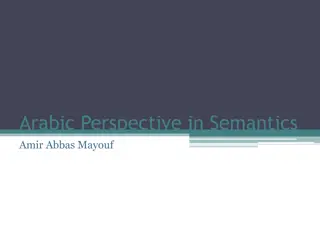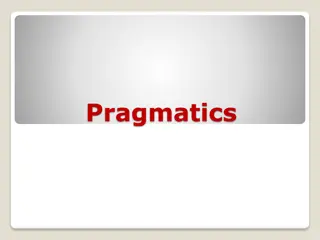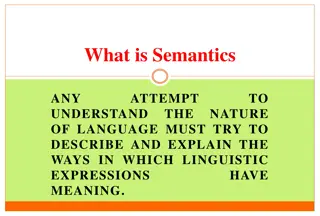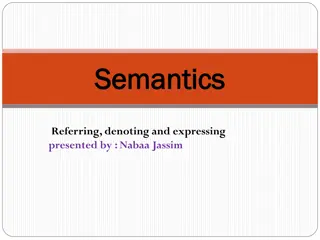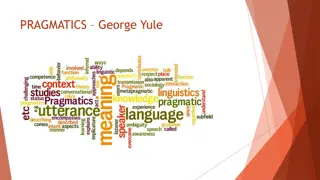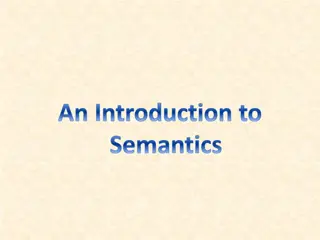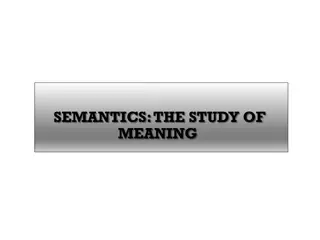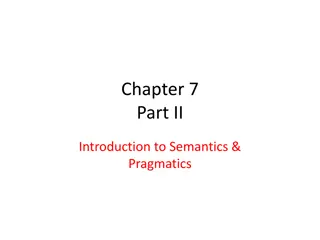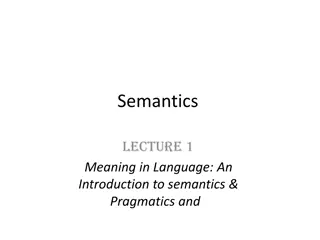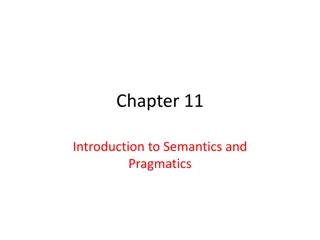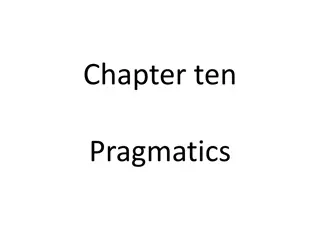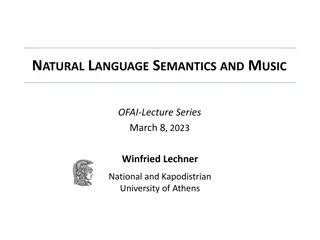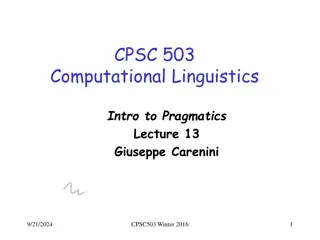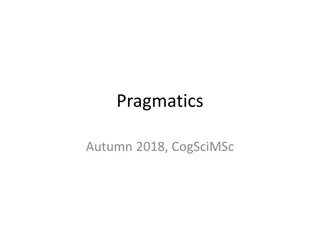An Exploration of Linguistic Meaning: Semantics and Pragmatics
Delve into the realm of linguistic meaning through the lenses of semantics and pragmatics. Explore how words and phrases carry literal meanings, while language usage in social contexts creates both literal and nonliteral meanings. Uncover the intricate interplay between semantics, concerned with the explicit meaning of words, and pragmatics, focused on the functions and implications of language beyond mere description.
Download Presentation

Please find below an Image/Link to download the presentation.
The content on the website is provided AS IS for your information and personal use only. It may not be sold, licensed, or shared on other websites without obtaining consent from the author. Download presentation by click this link. If you encounter any issues during the download, it is possible that the publisher has removed the file from their server.
E N D
Presentation Transcript
Focuses on the literal meanings of words, phrases and sentences; concerned with how grammatical processes build complex meanings out of simpler ones
Focuses on the use of language in particular situations; aims to explain how factors outside of language contribute to both literal meaning and nonliteral meanings which speakers communicate using language
The study of meaning in use Provides tools to help us understand the meaning in a given social context, including the effect that language has on those involved in the speech situation Semantics the study of meaning outside of its contextualized use with a focus on the literal meaning of words and phrases
Semantics concerned with what language says Pragmatics concerned with what language can do Semantics sense Pragmatics force Semantics: words or lexemes are central to the study Pragmatics: events or potential events are of main interest
Speech act theory Conversational implicature Deixis Presupposition
We often think that the role of language is to explain, inform, describe, and say sth about the world Language also used to do things, such as promise, bet, request, threaten, warn, apologize, swear (in court), etc.
J.L. Austin, How to do Things with Words (1955) "It was for too long the assumption of philosophers that the business of a 'statement' can only be to 'describe' some state of affairs, or to 'state some fact', which it must do either truly or falsely. Wittgenstein: Don't ask for the meaning, ask for the use." - language as a vehicle for social activity
Austin suggested that most utterances are created not to describe , but to perform action His approach was not of What do sentences mean? but What kind of act do we perform when we utter a sentence?
Austin emphasized the contexts in which utterances take place and suggested that they should be defined as felicitous or not, rather than false or true Felicity conditions: describe all the circumstantial properties of an utterance which are relevant to its successful accomplishment
Austin questioned the truth value of statements, a view which centered on the conditions of an utterance that can be declared true or false Austin examined performatives: sentences that are used to do things, rather than declare or state sth
Performatives: I now pronounce you husband and wife Only certain people in certain conditions can do this kind of pronouncing; if the conditions are right, then a change has taken place through the uttering the words
Make a list of performative utterances. What new state of affairs do the utterances create? What conditions must be present for the new state of affairs to come about?
A) I promise to visit tomorrow B) She promised to visit tomorrow Sentences which perform actions performatives (A); other sentences (B) constatives A good test of whether a sentence is a performative is whether you can insert the word hereby before the verb (I hereby promise; *I hereby walk)
Syntactic markers of a performative utterance: 1) the subject is in the 1st person 2) the verb is in the simple present tense 3) the indirect object is you 4) it is possible to insert the adverb hereby 5) the sentence is not negative
Speech acts which in themselves constitute an action This aspect of language illocutionary force The illocutionary force of an utterance is its ability to carry out an act
Locutionary Illocutionary saying sth Perlocutionary saying sth Locutionary act Illocutionary act act: the act of saying sth act: the act of doing sth by Perlocutionary act act: : the act of achieving sth by
John Searle took work on speech acts further by introducing direct ad indirect speech acts "In indirect speech acts the speaker communicates to the hearer more than he actually says by way of relying on their mutually shared background information, both linguistic and nonlinguistic, together with the general powers of rationality and inference on the part of the hearer
There are speech acts which are so fundamental to communication that they are captured through the mood of our utterance: Indicative Interrogative Imperative Indicative mood Interrogative mood Imperative mood mood: giving information mood: request for information mood: command to do sth
The mood of each utterance signals its illocutionary force Context key in explaining what people are trying to do with the language they use
Scenario 1:(in an elevator, 3 people, A and B know each other, C is smoking: A (to B): Ahem, did I ever tell you that I am allergic to cigarette smoke? Scenario 2: (A is filling in a form for a dating service): A (writing on form): I am allergic to cigarette smoke.
1. Would you mind handing me the salt? 2. Go ahead, try it. See where that ll get you! 3. Honey, the phone s ringing! 4. I have always wanted to have a pair of earrings just like those. 5. I m sure I must look awful.
1. DSA = requesting information ISA = commanding or requesting service 2. DSA = commanding ISA = warning 3. DSA = informing ISA = requesting a service 4. DSA = informing ISA requesting (a gift?) 5. DSA = informing ISA fishing for complement/apologizing for state
The function of the legal language usually seen as directive: used to impose obligations or to confer rights, to command or empower: mandatory and discretionary law Law uses language as a tool, an instrument for achieving things in the world; linguistics language as an object of study
In the communication process, whenever acts become formalised, they involve rules and conventions, or shared group commitments , which seem to correspond to J. Austin s felicity conditions and allow to recognise whether the act is valid or not
H.L.A. Hart commented on linguistic speech acts and pointed to their correspondence with formal legal acts such as the transfer of property or making of a will Suggested that performative utterances should be called operative utterances, evoking the analogy with what lawyers called operative words in legal language
Acts in law presuppose that the performer, in order to perform the act, needs to be able to exercise their legal power These powers, e.g. to enter a contract, to make a will, or even to enact a law, presuppose power conferring rules which stipulate which persons and under which conditions can perform the act
The interpretation of any legal document requires analysis of a relevant intention which has been incorporated into the text The notion of intentionality relates to the problem of implicitness and explicitness in language Grice s conversational implicatures (1975)
Imagine you overhear the following conversation: A: Are John and Mary back together again? B: I saw a red Porche parked outside 1128 Green Street last night and it was still there this morning!
In the exchange above, we might assume that B s response is providing A with the information requested. We can make the connection between the question and the answer by relying on presupposition: B presupposes that A also knows the following: John has a red Porche Mary lives at 1128 Green Street
In order to help us understand how context works in deciphering meaning in a given situation, we can look to Grice s Cooperative Principle, which explains how people act in conversation: Make your conversational contribution such as is required, at the stage at which it occurs, by the accepted purpose or direction of the talk exchange in which you are engaged
Grice is not telling us what to do, but rather providing an explanation for how we behave in communicative situations ad how we assume other people behave
Grice further divided his Cooperative Principle into sub-principles of: Quantity Relevance Quality Manner
Quantity Maxim 1. Make your contribution as informative as is required Maxim 2. Do not make your contribution more informative than is required. Quantity: :
Relevance Maxim 1. Be relevant. Relevance:
Quality Maxim 1: Do not say what you believe to be false. Maxim 2. Do not say that for which you lack adequate evidence. Quality: :
Manner Maxim 1: Avoid obscurity of expression. Maxim 2. Avoid ambiguity. Maxim 3. Be brief. Maxim 4. Be orderly. Manner: :
When we break any of the sub-principles, we create an instance of conversational implicature A: I heard you did well on the exam B: Yes, and pigs fly. Flouting the maxim of quality, as I am telling an obvious untruth conversational implicature: :
Observing the maxims Violating one or more maxims (e.g. lying) Opting out (e.g. refusing to answer a direct question) Not fulfilling one maxim because of a clash with another Flouting a maxim in order to make a conversational implicature
1. The speaker deliberately flouts a conversational maxim to convey additional meaning not expressed literally, e.g. a speaker responds to the question: How did you like the guest speaker? with the following utterance: Well, I m sure he was speaking English . If the speaker is assumed to be following the cooperative principle in spite of flouting the Maxim of Quantity, the utterance must have an additional nonliteral meaning, such as: The content of the speech was confusing.
2. The speakers desire to fulfil two conflicting maxims results in his flouting one maxim to invoke the other, e.g. when he responds to the question Where is John? by saying: He s either in the cafeteria or in his office The Maxim of Quantity and the Maxim of Quality are in conflict: a cooperative speaker doesn t want to be ambiguous but also doesn t want to give false information by giving a specific answer in spite of his uncertaity. By flouting the Maxim of Quantity, he invokes the Maxim of Quality
A. Hows your work coming along? B. It sure is sunny outside.
B is flouting the maxim of relevance. Given that B responds with an utterance which is clearly irrelevant, A can assume that work is NOT coming along
1. In a recommendation letter for a sales job: Dear Sir, I have been asked to write a few lines in suport for Jon Smith s application for work in sales within your company. What perhaps is most ipressive about John is that his appearance is impeccable, and his class attendance has been faultless. Sincerely, A.
The maxim of quantity, the letter is not very informative. This seems t ocommunicate that A does not have very much to say that is positive about John, and to avoid violatind the maxim of Quality and lying, and to avoid attacking John, A is not as informative as the situation requires
2. A. Do you like Annes new shoes? B: I cant imagine where she s got them from. B flouts the Maxime of Relevance, as the utterance does not answer A s question, perhaps to avoid either disagreeing with A or violating the Maxim of Quality and lying about liking the shoes
Do you think the kids would like some of that freezing cold creamy concoction that could be served in an edible dylinder-like container? A flouts the Maxim of Manner, as it would be much clearer and briefer to say ice-cream . The hearer can thus understand that A does not want the kids to know about the possibility
A: How did Mary and John do on their exam? B: Mary did fine. B flouts the Maxim of Quantity, as no information is provided about John. Thus A will assume that John did not do well, and that B does not want to provide displeasing information.
A. Were you invited to Johns party? B: Were you? B flouts the Maxim of Relevance in not providing an answer to A s question. A might thus understand that B does not want to hurt his/her feelings

 undefined
undefined





